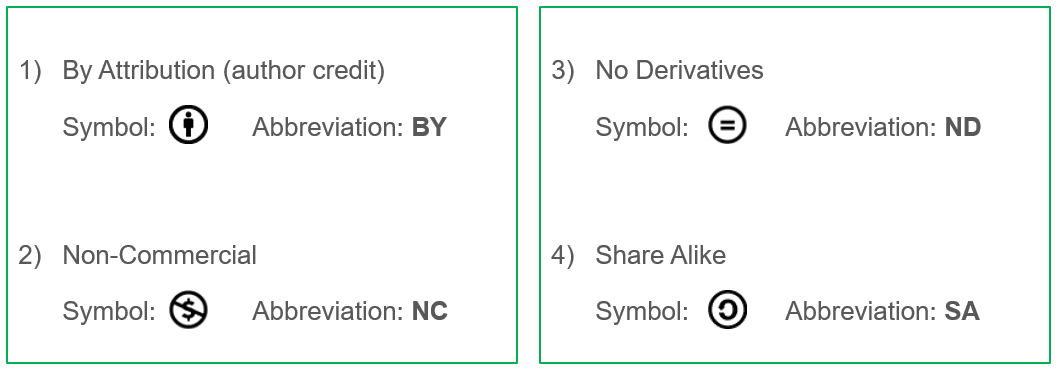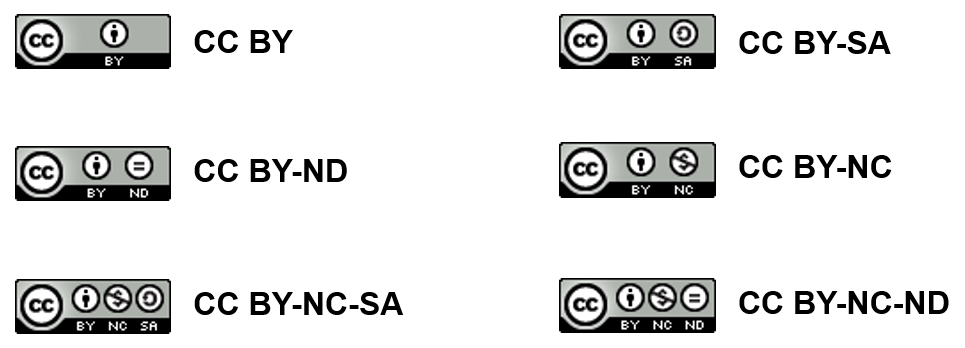Frequently asked questions about copyright for researchers
All literary and artistic works are protected by copyright law. As a researcher, you therefore need to be aware of how you may use material from books and articles, for example images, tables and figures.
Here you will find answers to the most common questions regarding the use of copyright-protected material. The answers are intended to be as practical as possible and are not intended to be in-depth explanations about the copyright legislation itself.
What is copyright?
Copyright can be divided into two parts: The moral rights and the economic rights.
As a researcher, you have the moral right to decide how your research publications are used. You also have the right to always be credited as the author when your publications are used and cited by others.
The economic right gives you as the author the right to use and dispose of the work by publishing it. If you, as an author, write an article for publication in a journal, an agreement is usually drawn up in which you give the publisher the economic right to publish the article and decide how it may be distributed. In such an agreement, 'copyright transfer agreement', it is described which rights are transferred to the publisher and which rights you, as author, retain.
Here is an example of such an agreement: Example contract External link, opens in new window.
External link, opens in new window.
If you publish your article open access, the publication agreement is designed in a slightly different way. The article will then be made freely available to everyone and will have a so-called Creative Commons license that describes how the reader may use the article. However, as the author you still retain the basic moral copyright and must always be credited as the author when the article is used and cited by others. Through the agreement, the publisher may have the right to use the article in various contexts specified in the agreement, for example translations and inclusion in other publications by the publisher.
How can I use other people's images?
If an image or figure (diagram, table) is published in an article, a book, or online, in principle, you must always have the author's or publisher's permission to reproduce it in your own publication. That is, you must obtain a license (the right) to use it. For the publisher to whom you send a manuscript, it is very important that you can certify that you have received permission to use other people's images in your text. Such a license is obtained in slightly different ways depending on how the image is published:
Images from published articles and books
You obtain the license by contacting the publisher that has published the image. Most journal publishers use the web-based service RightsLink which makes obtaining a license quick and easy. If you are going to use the image in an academic, non-commercial context, such as for example in a thesis, you usually get a reply directly on the screen that you do not need permission to use the illustration if it does not apply to, for example, more than three. You must of course always cite the original source.
Images from commercial image agencies and museums, etc.
In this case, the picture agency or museum usually has an ordering function and additional costs may apply.
Images that already have a Creative Commons license
For these, you do not need to contact the author or the publisher, as such a license is already available with the image. The Creative Commons license specifies the ways in which you may use the image. You do not need to do anything more than to indicate the license in cases where there is one in connection with the image in your text and refer to the source in the usual order.
Images that are free and not subject to copyright
The images may have a Creative Commons license of the type CC0 or Public Domain Mark where the author has waived their copyright. It may also be the case that the images are so old that the copyright protection has expired, i.e. 70 years after the author's death. In cases where there is a CC0 or Public Domain license, there is no requirement that you provide credit, but we recommend that you do so anyway.
Images on the internet that do not have a license listed
This can be photos or artistic images on personal or organizational websites. Contact the person or organization behind the website to seek permission to use the image. If a photographer or artist is listed next to the image, you should see if you can get hold of that person directly. You can also search for the name of the image creator on the website of a copyright organization like Bildupphovsrätt ("Image copyright") and seek permission through them. Costs may apply.
Can I reuse my own illustrations that have been published before in a new article?
If they are included and published in a journal article or book/chapter published by a publisher then the publisher has the economic rights to the image and you need to apply for a license to reuse them in a new article (see question above about this). On the other hand, if the original text with the illustrations was published with a Creative Commons license, you can reuse them with the same type of license and refer to the previous article.
If you have illustrations or figures that you want to reuse several times in different publications, a solution could be to upload these on a platform such as figshare. Then you will receive a CC license and a DOI link that you can use when citing the illustration or figure in a new article.
You can read about this idea in this blog post.
Can I republish my already published articles in my thesis?
Usually, a summary thesis is published in both printed and digital form. In the digital repository DiVA, only the summary ("kappa") is uploaded for copyright reasons. Publishers that publish scientific articles generally have no problem reproducing articles in a non-commercial, limited-edition print edition. However, some publishers may have problems with a digital version that is openly available as it has a potentially much greater distribution.
Just like the procedure under the questions above, you must have the author's, i.e. the publisher's, permission to publish them as part of your thesis. If they have been published in an open access article with a Creative Commons license, you do not need to obtain permission from the publisher as you already have a license.
Can I include illustrations from my articles in the summary?
The same applies here as for the question "Can I reuse my own illustrations that have been published before in a new article?" above. If they have been published in an open access article with a Creative Commons license, there is no problem as you already have a license. However, do not forget to write this below the illustrations and refer to the original article.
If it is an illustration that is not published under a Creative Commons license, you may need the permission of the author, i.e. the publisher, to reuse it in the coat. If it concerns an illustration in a journal, the publishers very often use the web-based service RightsLink, which makes it easy to apply for permission and get an answer immediately.
How much text can I quote?
You have the right to quote parts of a work in accordance with good practice and to the extent justified by the purpose without the permission of the copyright holder according to the right of quotation. There must therefore be a need to include parts of someone else's work in your own text. If you are going to review a text critically or want to highlight your reasoning or interpretations of a work, it may be justified to quote parts of the text in your article. How much you can cite varies from case to case, but in scientific contexts it can be quite large parts depending on the context. However, you may not quote an entire work.
Please note that this citation right only applies to text, not images!
What is meant by good practice?
Good practice means that you indicate the reference to the source and do not quote unnecessarily. The quotation should serve to elucidate, provide context, or otherwise bolster one’s own work.
How do I seek permission from the copyright holder?
If you are seeking permission from a copyright holder, or if the publisher or organization behind a website where the image is located does not have an application form, please consider the following:
- It is important that you specify the context in which you intend to use the work or image:
– If it concerns an article in a scientific journal, book, or report etc.
– Whether the publication will be in print or digital form or both.
– Whether it is in a commercial or non-commercial context. - The permission must be in writing and must be saved. It serves as a receipt if questions about the permit should arise.
In cases where the application is made via a form such as on iStock or similar image agencies, you are usually allowed to enter the above information.
On a publisher's website, you may find headings like "Rights & Permissions" and the like that lead to a page with information on how to apply for permission. Even in these cases, many large publishers use RightsLink for this. Contact us if you need help finding the appropriate contact method for the application.
How do I use RightsLink (CCC)?
RightsLink is a web-based tool created by Copyright Clearance Center (CCC) for applying for a right to use an image, figure, table, diagram, or all or parts of an article or book chapter, etc. Most major journal publishers use RightsLink in connection with the articles on their journal platforms.
In short, you do the following, although the steps may vary slightly depending on the publisher:
- Locate the article on the journal's website.
- In connection with the article, you should be able to see a link that can be called things like "Permissions", "Reprints & Permissions", "Request permission", "Get rights and content" etc.
- You should then get to the form for RightsLink, where you select from drop-down menus such as area of use, what in the article you want to use, in what form (printed and/or digital) etc.

Should you not find such a link, it may be that the publisher has an individual copyright page where you are either directed to RightsLink and can search for the publication first and then fill in the form or receive information on how to contact the publisher to apply for rights.
If you can't find a way to contact you, just contact stefan.carlstein@ju.se and you can get help.
A short film on how to obtain a license via RightsLink:
How to Obtain Permission To Reuse Figures and Tables – Figure Permission from Published Papers [5:32]
What is Creative Commons?
Creative Commons is a non-profit organization that has created a system of licenses to help those who want to share their works or who want to distribute their book or article freely. If you mark your works with a Creative Commons license, you specify the ways in which others may use the work without having to apply for permission from you or the publisher as the copyright holder. You can mark things like journal articles, books, chapters, articles on web pages, images and photos, PowerPoint presentations and YouTube clips, but also things like research data and learning resources.
CC licenses are based on four terms and these can be expressed either graphically with symbols or written with abbreviations:

These can then be combined in six different ways:

In addition, there are also two different symbols that indicate that a work is completely free.
- CC0 (CC zero) means that the author has waived all rights and you can use the work or image as you wish. The work has therefore become part of the public domain.
- The second symbol, the Public Domain Mark (PDM), is not really a license but a marking of material that has been identified as completely free and that is already in the public domain.
These concepts are not completely simple and if you want to read more about them, you can start here.

Where can I find free images?
There are a number of image services that have free images with a Creative Commons license that allows you to use them without having to seek permission.
Here is a small selection of sites with free images:
- Flickr
Free images and videos with the possibility to choose different types of CC licenses. - Smithsonian Open Access
Images of objects from the Smithsonian's more than 20 museums and research centers, archives and libraries. - Unsplash
Millions of free photos. Unsplash has their own license which is similar to Creative Commons. - The 34 best sites for free images and pictures
A website with an annotated list of 34 sites for free images.
NB! Don't forget to indicate the source you got the images from!
Text


